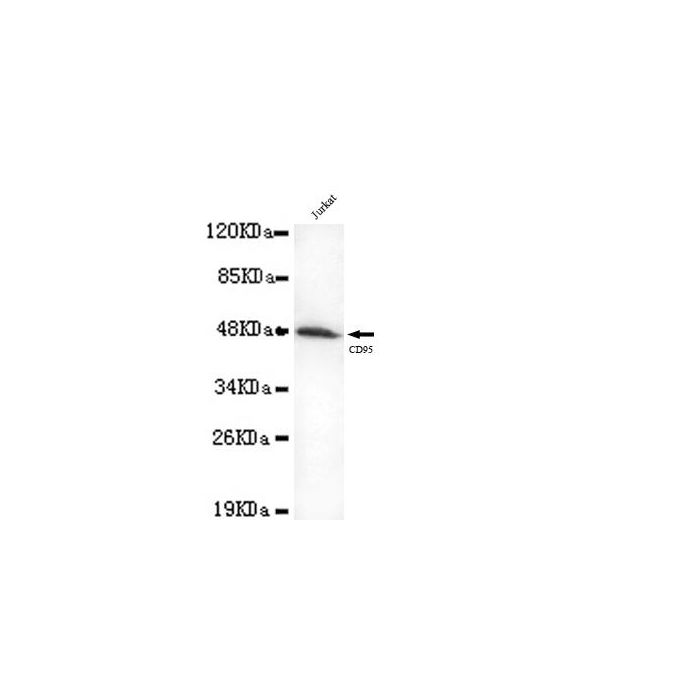CD95/FAS (C-terminus) (clone ), anti-human
€388.00
In stock
SKU
MB0079
Background:
Cytotoxic T lymphocyte (CTL)-mediated cytotoxicity constitutes an important component of specific effector mechanisms in immuno- surveillance against virus-infected or transformed cells. Two mechanisms appear to account for this activity, one of which is the perforin-based process. Independently, a FASbased mechanism involves the transducing molecule FAS (also designated APO-1) and its ligand (FAS-L). The human FAS protein is a cell surface glycoprotein that belongs to a family of receptors that includes CD40, nerve growth factor receptors and tumor necrosis factor receptors. The FAS antigen is expressed on a broad range of lymphoid cell lines, certain of which undergo apoptosis in response to treatment with antibody to FAS. These findings strongly imply that targeted cell death is potentially mediated by the intercellular interactions of FAS with its ligand or effectors, and that FAS may be critically involved in CTL-mediated cytotoxicity.
Alternative Name:
Tumor necrosis factor receptor superfamily member 6, Apo-1 antigen, Apoptosis-mediating, surface antigen FAS, FASLG receptor, CD95, FAS, APT1, FAS1, TNFRSF6
Application Dilution: WB: 1:1000
Specificity: This antibody detects endogenous levels of FAS (C-terminus) and does not cross-react with related proteins
Immunogen:
Synthetic peptide, corresponding to the C-terminus of Human CD95/FAS.
MW: Predicted band size: 45KDa, Observed band size: 45KDa
Swis Prot.: P25445
Purification & Purity:
The antibody was affinity-purified from mouse ascites by affinity-chromatography using epitope-specific immunogen and the purity is > 95% (by SDS-PAGE).
Format:
Purified mouse monoclonal in buffer containing 0.1M Tris-Glycine (pH 7.4, 150 mM NaCl) with 0.2% sodium azide, 50%,glycerol
Storage:
Store at 4°C short term. Aliquot and store at -20°C long term. Avoid freeze-thaw cycles.
For research use only, not for use in diagnostic procedure.
Cytotoxic T lymphocyte (CTL)-mediated cytotoxicity constitutes an important component of specific effector mechanisms in immuno- surveillance against virus-infected or transformed cells. Two mechanisms appear to account for this activity, one of which is the perforin-based process. Independently, a FASbased mechanism involves the transducing molecule FAS (also designated APO-1) and its ligand (FAS-L). The human FAS protein is a cell surface glycoprotein that belongs to a family of receptors that includes CD40, nerve growth factor receptors and tumor necrosis factor receptors. The FAS antigen is expressed on a broad range of lymphoid cell lines, certain of which undergo apoptosis in response to treatment with antibody to FAS. These findings strongly imply that targeted cell death is potentially mediated by the intercellular interactions of FAS with its ligand or effectors, and that FAS may be critically involved in CTL-mediated cytotoxicity.
Alternative Name:
Tumor necrosis factor receptor superfamily member 6, Apo-1 antigen, Apoptosis-mediating, surface antigen FAS, FASLG receptor, CD95, FAS, APT1, FAS1, TNFRSF6
Application Dilution: WB: 1:1000
Specificity: This antibody detects endogenous levels of FAS (C-terminus) and does not cross-react with related proteins
Immunogen:
Synthetic peptide, corresponding to the C-terminus of Human CD95/FAS.
MW: Predicted band size: 45KDa, Observed band size: 45KDa
Swis Prot.: P25445
Purification & Purity:
The antibody was affinity-purified from mouse ascites by affinity-chromatography using epitope-specific immunogen and the purity is > 95% (by SDS-PAGE).
Format:
Purified mouse monoclonal in buffer containing 0.1M Tris-Glycine (pH 7.4, 150 mM NaCl) with 0.2% sodium azide, 50%,glycerol
Storage:
Store at 4°C short term. Aliquot and store at -20°C long term. Avoid freeze-thaw cycles.
For research use only, not for use in diagnostic procedure.
| Is Featured? | No |
|---|
Write Your Own Review

